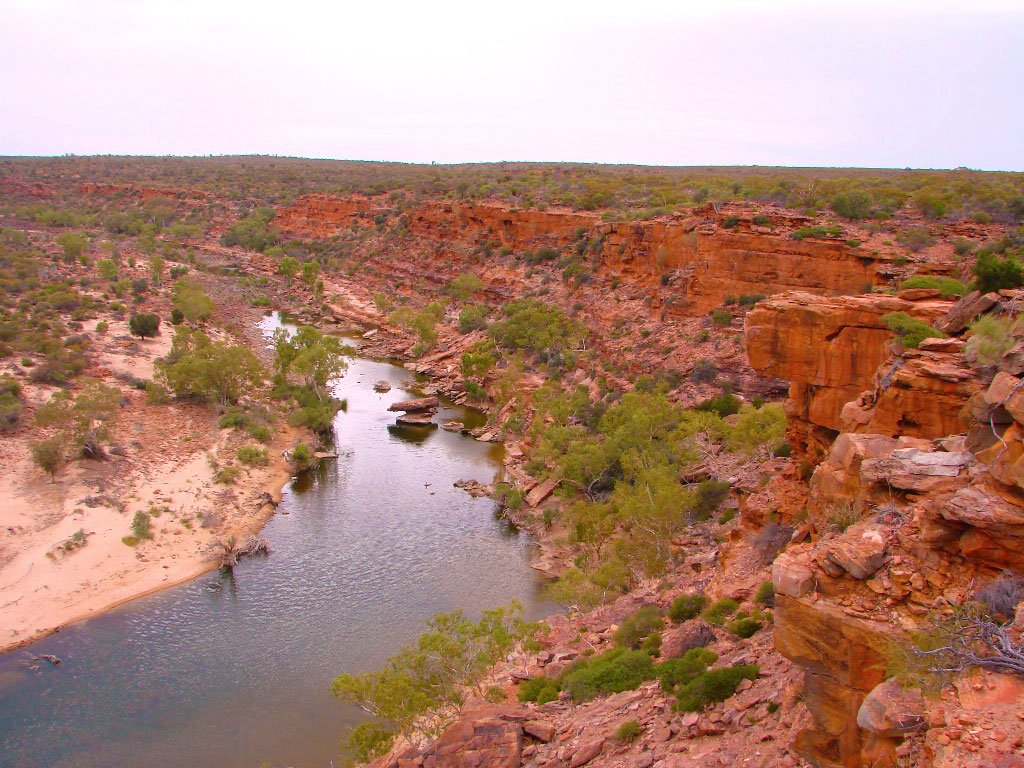Overview
- Highlights: Natures Window
- Distance: 8 km (Loop)
- Duration: 3 to 4 hours
- Conditions: Dry trail, with some steep sections, and easy to follow track markers
- Best Time to Visit: June to November
- Facilities: Toilets at beginning and end of trail, benches infrequently along trail
- Start/Finish: Nature’s Window car park
- Permit/Bookings: None required; entry fees apply to Kalbarri National Park (A$11 per car per day)
- Address: Kalbarri National Park, Western Australia
Author Reviews[display_rating_item_results rating_form_id=”2″ rating_entry_ids=”1″ show_category_filter=”false” show_options=”true” result_type=”star_rating” preserve_max_rating=”true” show_title=”false” show_count=”false” ]
Total Rating: [display_rating_result rating_form_id=”2″ show_count=”false” show_rich_snippets=true] [accordions load=”1″] [accordion title=”User Reviews” last] [display_rating_item_results rating_form_id=”5″ show_options=”true” result_type=”star_rating” preserve_max_rating=”true” show_title=”false” show_count=”true” show_rich_snippets=true] [/accordion] [accordion title=”Add Review”][display_rating_form show_email_input=”true” show_comment_textarea=”true” show_name_input=”true” rating_form_id=”5″] [/accordion] [/accordions]
Summary
The Murchison River gorges in the Kalbarri National Park are particularly spectacular. Its path through sandstone cliffs and out to the Indian Ocean also makes for a stunning scenic view, excellent bushwalking, hiking and trekking.
Kalbarri National Park: Loop Walk Trail
The rugged terrain and relative seclusion of the Murchison River gorges in the Kalbarri National Park are quite amazing. Short walks or longer hiking trails provide access to lookouts along the river gorge, with the most popular ones being the Loop Walk Trail and Z-Bend.
Feeling quite adventurous and energetic, we attempted the 8 km Loop Walk Trail. Knowing that it would get to 40 degrees by midday, we had to complete the trip by late morning. So a 6 am start got us on the track nice and early.
The first 12 km of the Loop access road is sealed, however the next 14 km is unsealed and rough in sections. Since we were in a 2-WD, we had to go slow and take extra precaution while driving.
As we were the first car to enter the Kalbarri National Park that day, there were kangaroos everywhere. They seemed to be hopping out of the bushes on our right, and hopping across the road to the left side, where they would completely disappear into the thick bushes.
The challenging Loop Walk in Kalbarri National Park highlights the erosive power of the Murchison River, which has carved magnificent gorges to reveal the red and white banded rock. The Loop provides different views of the winding gorge below from several lookout points positioned around the circuit. The trail begins at the top of the river gorge, and winds its way down to the banks of the Murchison River, to eventually climb back up to the top of the sandstone cliffs.
[singlepic id=3176 w=720 h=560 float=center]
A key attraction here is Nature’s Window, a natural, wind-eroded rock arch in the layered sandstone that superbly frames the upstream view of the river. It is a must-snap photograph opportunity in Kalbarri National Park. A moderate, 800m return walk from the car park leads to Nature’s Window. It is also the starting and ending points for the Loop Walk Trail.
The geology of the area is fascinating. The thinly bedded, red and white banded rocks through most of the river gorge were deposited millions of years ago on tidal flats. Rippled surfaces can be seen around Nature’s Window. These ripples were formed during ancient times by waves moving over tidal flats in a shallow sea.
The first hour of the hike was spent walking along the top of the cliffs. The river flowed below us as we walked along the red sandstone path, and the view was simply superb. Every step gave us a new image of the landscape, and I would stop every two minutes to capture it in print. It felt like we were walking on the top of the world, as there was nothing on either side of us, just the sheer-faced, red cliffs below us.
[singlepic id=3179 w=720 h=560 float=center]
It is incredible how the wind and rain have sculpted the rocks around the top of the cliffs over millions of years, and how the Murchison River has cut its way through these strong sandstone cliffs.
Some rock layers in overhangs at The Loop look as if they have been riddled by plant roots. These are actually fossilised burrows left by ancient worms that once sheltered in the sand. Tracks and trails on flat surfaces show where animals crawled across the damp sedimentary surface.
The early morning air was fresh with a cool breeze blowing on top of the cliffs. However, there was a parade of flies following us along the way, and there was no way to get rid of them. No amount of mosquito repellent worked as they seemed to be immune to any and everything. I remember seeing a tourist with a mesh covering his face, and even though at that time I thought it looked ridiculous, I wish I had one of those covering my face.
[singlepic id=3166 w=720 h=560 float=center]
The trail started winding its way down the cliff face and it got quite steep in places. Sometimes the trail followed rock platforms and this was a scramble at times. Some of the cliff edges were unstable, and some stones lost their grip and rolled down to the river below. For about an hour we hiked down to the flat bottom of the river bed, and what looked so distant from atop the cliffs now looked so near.
The path was well marked, so we could see where we needed to go, as one wrong step could result in a twisted ankle if not worse. After a lot of twist and turns, slipping and sliding, we finally made it to the bottom of the river.
[singlepic id=3169 w=720 h=560 float=center]
The views from the river looking up towards the cliffs were so different. It was here that we noticed the different shades of red in the rocks around and above us. On the other side of the river, some of the cliffs were magnificent shades of red and pink.
Along the Murchison river are sandy beaches, river gums and the possibility of swimming. The still water of the river was calming, and we walked along the side of the river soaking up the solitude.
Graham noticed animal paw prints that looked quite big for a bush animal. On closer inspection we concluded that they had to be kangaroo prints fresh in the sand by the river. Whether they were or weren’t, we didn’t want to think about what bigger animal it could be.
[singlepic id=3164 w=720 h=560 float=center]
Before the river bends towards the Indian Ocean, the trail climbs out of the gorge back up to Nature’s Window. We had to make our way back up the cliffs before the sun got too hot. The water in our camelpacks was dwindling fast so we needed to ration it as best we could.
On our way up we noticed some ant hills, and I get Graham to stand near one to indicate the size of an ant hill in relation to his height. I had seen numerous ant hills on our road trip through Western Australia, and was amazed by their sheer size and volumes.
Colonies of ants live below these ant hills which are interconnected through underground passages. The ant hills are a type of protective covering that protects their living quarters from the natural elements as well as predators.
[singlepic id=3174 w=720 h=560 float=center]
The trip back up to the top of the trail seemed a lot quicker than the descent to the river, and we made our way up to the top at a good pace.
On our way up, we saw a couple of kangaroos peering out at us from behind some bushes. It had been impossible to get near them during the trip, as they seemed to be quite timid and would run off at the sight of people, so it was a treat to get so close to them in the wild.
When we got back to Nature’s Window, there were numerous tourists about as it was around 10 am. Having finished the Loop Walk Trail, we jumped into our car and drove the 8 km or so south to Kalbarri National Park Z-Bend Trail.








Would you rate this hike as easy, moderate or hard?
Hi Janell,
The grade for this hiking trail is ‘Moderate’. There are some steep sections with loose rocks so you need to be careful when climbing down to the river.
Hope that helps.